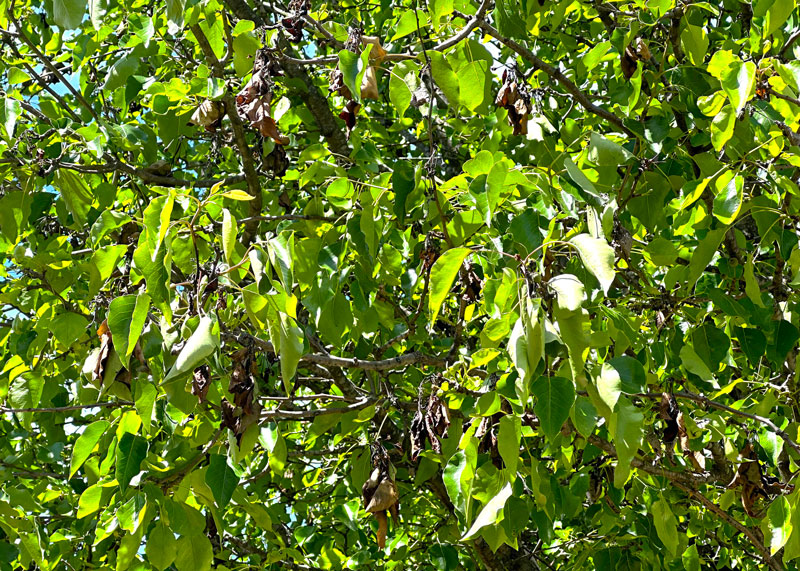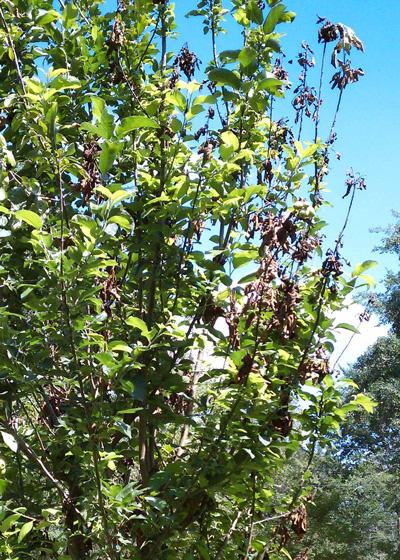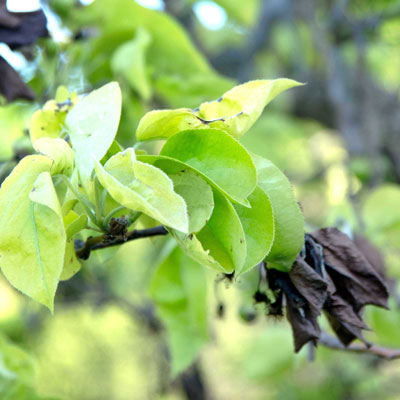No Fun with Fire Blight
This is a bacterial disease that makes susceptible plants look as though they’ve been hit by a blow torch. It’s serious, and for infected plants, it can be fatal.

The important facts…
You’ll find extensive information online if you’ll search key words: “university fire blight pear trees.” That will get you straight to the ag schools and the people who work with pears and this disease day in and day out. Here’s a synopsis.
• Fire blight Erwinia amylovora.
• Bacterial disease that is widespread all over the world.

• Attacks only members of the Rose Plant Family. List includes pears, apples, crabapples, pyracanthas, loquats, cotoneasters, photinias, quince, plums, peaches, cherries, almonds, roses and others. If a plant is not in the Rose Family, any problem it might have will not be fire blight.
• Bacteria are carried into the open flowers by bees. They are picked up in the moist ooze (to quote Washington State University, “by the billions”) and carried down into the soft new growth of that year’s twigs.

• Twigs die suddenly – in a matter of just a few days. They develop a characteristic shepherd’s crook as they dry. Dead leaves and shriveled fruit hang in place on the small branches.
• Lesions will develop on the stems of diseased plants and those lesions serve as the overwintering places for the bacterium for the following year.
Coping with fire blight…
• Prevention begins with choice of resistant varieties such as Orient, Kieffer and Moonglow.
• Avoid severe pruning that would stimulate vigorous vegetative regrowth. It is far more susceptible to infection by the bacterium.
• Avoid high-nitrogen fertilizers for the same reason.
• Apply a copper-based fungicide at the same time that you are applying an antibiotic spray (Agristrep) to stop the bacterial invasion. These sprays should be made while the plants are in full bloom.
• Should your pear tree become infected, prune out the diseased wood by cutting the branch 12 to 18 inches below the visible lesion. There is conflicting advice as to whether you should disinfect your pruning tools between cuts, but it certainly won’t hurt to do so. Use a 10 percent solution of chlorine bleach. Oil the tools after the final cut.
A little bit more…
Your Web search will turn up many good matches regarding Fire Blight. Almost every Land Grant University will have an extensive write-up.
For home gardeners in Texas, this one from Georgia is good.
https://extension.uga.edu/publications/detail.html?number=C871
For the ultimate detail, this information from the heart of apple and pear land, Washington State University, is outstanding.
https://treefruit.wsu.edu/crop-protection/disease-management/fire-blight/
